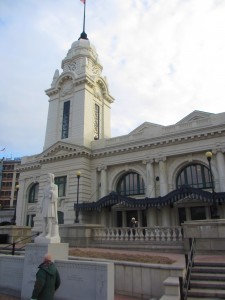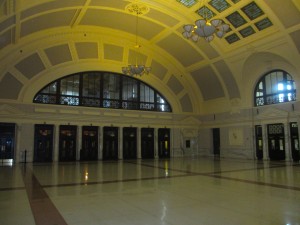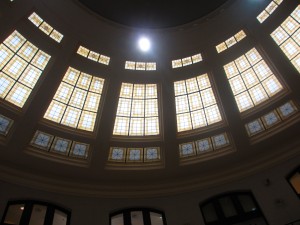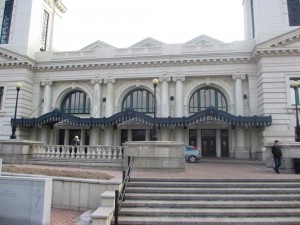 My first encounter with Union Station was in November. As a freshman still learning the ropes, I was exploring all of my transportation options to get home to the greater Boston area. For Thanksgiving break, I took the MBTA Commuter Rail, which conveniently leaves Worcester from Union Station.
My first encounter with Union Station was in November. As a freshman still learning the ropes, I was exploring all of my transportation options to get home to the greater Boston area. For Thanksgiving break, I took the MBTA Commuter Rail, which conveniently leaves Worcester from Union Station.
Leaving from Holy Cross in a SGA shuttle, I headed up Southbridge Street and passed through the typical knitty-gritty industrial areas of South Worcester: old factories, train tracks, sand and coal deposits, and auto supply warehouses. After a sharp right turn and a pass around a tight rotary, I arrived at the Union Station driveway. I shuffled out of the SGA van, nearly colliding with an oncoming taxi. I caught a whiff of city smoke, which was a mix of wood, oil, and chemicals, on a late November evening. The station’s two domes stood tall: the left side held an American flag, and on the right side flew a Massachusetts state flag.
I stepped inside to a large rectangular room that was completely empty of people and furniture, sporting only a few benches along the sides. A restaurant sat on one end of the hall, with restrooms on the other. The black moldings on the windows and doors clashed with the white walls to create the feel of a refurbished old style. The domed ceiling alternated between stained glass windows and multi-light chandeliers. Intricate molding lined the walls above the doors and windows, culminating in stalky pillars to hang simple light fixtures. The hollowness produced no sound; only a high pitch rang through my ears. Despite how worn-down the soles of my sneakers were, I squeaked as I traversed the spotless tile floor.
 I continued into the next room, which is a smaller version of the grand entryway. A line of ticket windows sat off to the left, and stairs leading to the train terminal lay straight ahead. I purchased my ticket from a smiling woman with a “T” on her polo shirt, and trudged up the stairs. As I waited for the train, a mix of students headed home for the holiday, young professionals, middle-aged travelers, and children with parents surrounded me. It was dark by the time the train departed; all I saw out the train windows was the blur of city lights whizzing by my stationary window.
I continued into the next room, which is a smaller version of the grand entryway. A line of ticket windows sat off to the left, and stairs leading to the train terminal lay straight ahead. I purchased my ticket from a smiling woman with a “T” on her polo shirt, and trudged up the stairs. As I waited for the train, a mix of students headed home for the holiday, young professionals, middle-aged travelers, and children with parents surrounded me. It was dark by the time the train departed; all I saw out the train windows was the blur of city lights whizzing by my stationary window.
I returned to Union Station this month to get a closer look and to snap some pictures. Within seconds of my flash going off inside the station, a security guard approached me to warn that cameras aren’t allowed inside the station. I quickly snapped a few more before he escorted me out, giving a short rundown on the building’s history. Between 1975 and 2000, the station was abandoned and not in use. It was redeveloped twelve years ago as a much needed train and bus port. Nonetheless, Union Station’s history stretches much further back: the original was built in 1875 in the beginning of the railroad boom. In 1911, a new station, the one whose foundation exists to this day, was built to accommodate the growing masses of immigrants traveling out from Boston. I was particularly interested to learn that the main room, which formerly served as the terminal, is now used for weddings and other functions.
Once I reached the outside, I took a step back to appreciate the station’s history. While much of Worcester seems to be caught between modern times and industrial times, as the clash between the sparse skyscrapers and the abandoned factories shows, Union Station represents a harmony between the two eras. It serves as a useful and attractive transportation hub, while maintaining the style of the old Worcester. I was proud to see a living and breathing piece of the city’s history.

